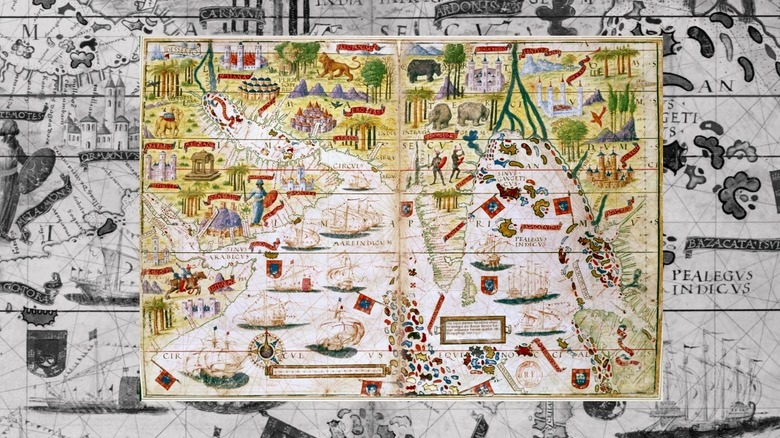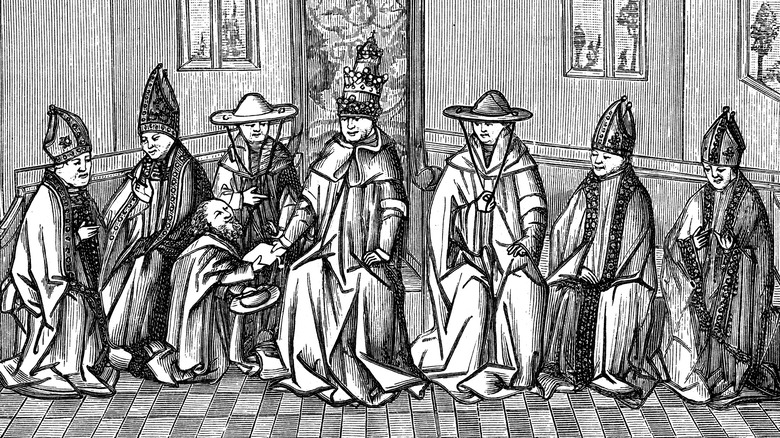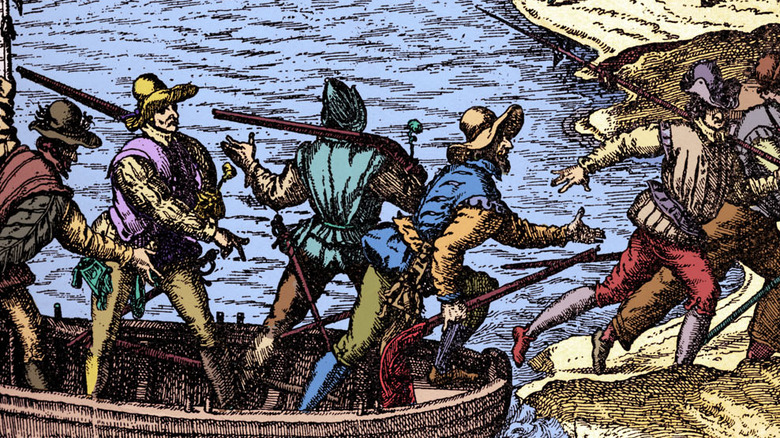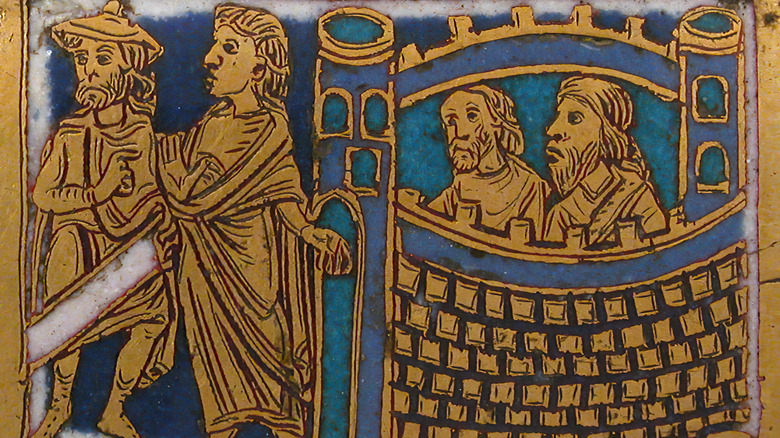The Real Reason We Can't Find Thibaud De Castillon's Lost Treasure
Thibaud de Castillon was not the most devout bishop to ever live, but he was certainly among the most wealthy. The 14th-century Bishop of Lisboa amassed substantial stores of gold, silver, jewels, and ecclesiastical luxuries obtained through his dabbling in overseas trade. De Castillon, much to the ire of the royal Cortez (who was tiring of the church laying claim to more land than the state), entered into mercantile contracts with an assortment of colleagues, speculatively investing in the wool trade, and eventually finding his assets tied up in the elite sea salt trade of the 1300s (via Williman and Corsano; Medievalists).
Records obtained from the Vatican Archives (and republished in a recent book entitled "The Spoils of the Pope and the Pirates, 1357: The Complete Legal Dossier from the Vatican Archives") reveal that de Castillon's dealings were far from above board. He used clever legal language in his contracts (blending "commenda" and "depositum" contracts, in an unconventional use of legal language perhaps used to obscure his dealings from church scrutiny (as Williman and Corsano note), and the Vatican's surviving records of his correspondence reveal negotiations regarding somewhat substantial fees and debts. While concealing his commercial ventures was likely wise, his less-than-righteous financial schemes were no secret. Pope Innocent VI simply didn't care. In fact, upon de Castillon's death, Pope Innocent VI would claim all his wealth as "spolia" (or property of the Church). If anything, de Castillon's experience in mercantile trade made him that much more useful to the Church.
The Pope
Thibaud de Castillon accrued substantial wealth throughout the course of his life and his tenure as bishop. Pope Innocent VI knew this, and spared no convenience to make sure his estate made it into the Church's coffers. Upon de Castillon's death in May 1356, the pope wasted no time and quickly appointed another bishop (who had formerly served as papal treasurer) — the Pope's representative had been already residing at de Castillon's estate since the first sign of his illness struck. On May 28, 1356, Thibaud de Castillon died. Thus began the complicated matter of unraveling his estate.
His wealth was meticulously documented by the pope's executor, who chronicled over 1,800 pounds of silver and gold plate, over twenty mules and horses, and a valuable library of precious works, according to Williman and Corsano's summary translation of the Vatican reports. In the years following de Castillon's death, the pope's executor was obligated by ill fortune to spend 3,000 pounds on cathedral repairs after an earthquake struck Lisboa, and an additional 5,000 in extortion to quell "vexations" from the Infante who temporarily accumulated power through a rebellion against his royal father. Casting these irritations aside, the pope's executor left Lisbon in 1357 en route to the pope's residence in Avignon (France), with the vast majority of de Castillon's wealth in tow.
The Pirates
The pope's executor — aboard the São Vicente with the late de Castillon's worldly acquisitions — could not, however, rest long. Off the coast of Cartagena (Spain), the São Vicente was captured by pirates. As the Bible says, "Give to the pope what is the pope's, and give pirates whatever they ask for, because pirates are always armed." These pirates were well-armed indeed. The pirate Martin Yanes (or Martinus Johannes) of Sevilla and Antonio "Botafoc" of Genoa (Botafoc meaning "fire blast" — via Live Science) were not deterred by exclamations of "spolia" and the invocation of Pope Innocent VI's name.
The pirates Martinus Johannes (of Sevilla) and Botafoc (of Genoa) presumably took the São Vicente for all that it was worth, and thus procured the spoils of the bishopric. From surviving accounts in Vatican records, Martinus Johannes is not heard from again after this point. Botafoc, however, has a continuing role in the Vatican's account, and was not lucky enough to perhaps evade the cruel ledger of history.
According to the Vatican records as recounted by Williman and Corsano, Botafoc galley was "blown ashore" near Carnon Plage (via Williman and Corsano) and with it, de Castillon's fortune.
The Treasure
The spoils of the late bishop's myriad investments, which included gold coins, silver plate, jewels, tapestries, ecclesiastical rarities, compact altars, and fine rings, were all snatched by the hungriest beast of them all — the sea. Thankfully (for these gentlemen), the shipwreck was close enough to Aigues Mortes that the treasure began to wash ashore, and royal notaries swarmed in to "take inventory," profusely attesting it belonged to Pope Innocent VI (according to Williman and Corsano). The papal subcollector came ashore and declared the treasure "spolia."
A brief reference is made in the Vatican text to the fact that some of de Castillon's treasure was found by local fisherfolk. These fisherfolk are not mentioned again. The pirates were hanged and dubbed "enemies of mankind," and the higher-ranking pirates were thrust into the pope's jail and slapped with steep fines.
Martinus Johannes, presumably, continued sailing and conducting his various pirate ventures on the perilous seas of a world freshly-erupted into French and English War. No one knows exactly what happened to the treasure, but we do know Pope Innocent VI never got all of de Castillon's "spolia" he decreed was his due. Some, perhaps, slipped through the fingers of hungry vicars and found its way to the ocean floor, or perhaps even into the hands of the needy. The rest of the pope's "spolia" was added to Innocent VI's teeming mounds of accumulated wealth, exchanged as gifts to royals, or simply stockpiled amongst the papal reserves. These reserves grew increasingly vast throughout the Middle Ages, and during the rise of the Holy Roman Empire's prime centuries of dominion. The rest, as we know it, is history.



